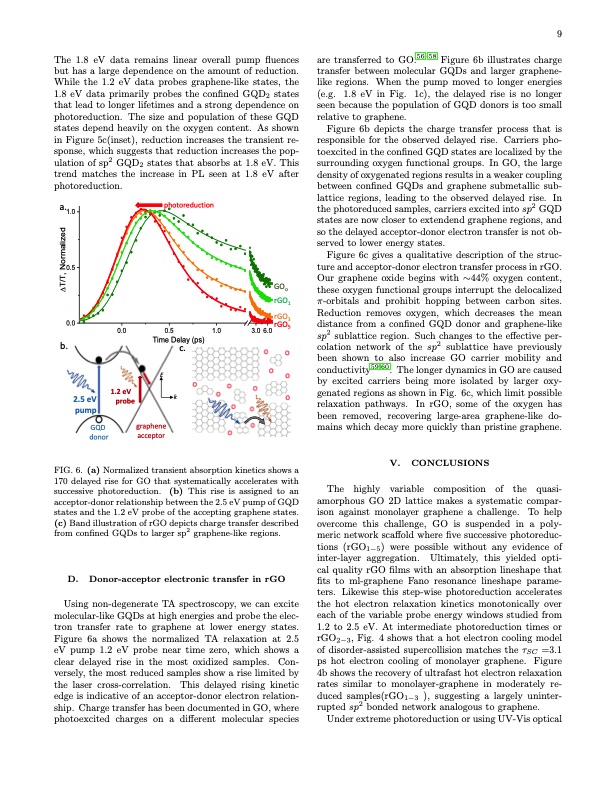
PDF Publication Title:
Text from PDF Page: 009
The 1.8 eV data remains linear overall pump fluences but has a large dependence on the amount of reduction. While the 1.2 eV data probes graphene-like states, the 1.8 eV data primarily probes the confined GQD2 states that lead to longer lifetimes and a strong dependence on photoreduction. The size and population of these GQD states depend heavily on the oxygen content. As shown in Figure 5c(inset), reduction increases the transient re- sponse, which suggests that reduction increases the pop- ulation of sp2 GQD2 states that absorbs at 1.8 eV. This trend matches the increase in PL seen at 1.8 eV after photoreduction. are transferred to GO.56–58 Figure 6b illustrates charge transfer between molecular GQDs and larger graphene- like regions. When the pump moved to longer energies (e.g. 1.8 eV in Fig. 1c), the delayed rise is no longer seen because the population of GQD donors is too small relative to graphene. Figure 6b depicts the charge transfer process that is responsible for the observed delayed rise. Carriers pho- toexcited in the confined GQD states are localized by the surrounding oxygen functional groups. In GO, the large density of oxygenated regions results in a weaker coupling between confined GQDs and graphene submetallic sub- lattice regions, leading to the observed delayed rise. In the photoreduced samples, carriers excited into sp2 GQD states are now closer to extendend graphene regions, and so the delayed acceptor-donor electron transfer is not ob- served to lower energy states. Figure 6c gives a qualitative description of the struc- ture and acceptor-donor electron transfer process in rGO. Our graphene oxide begins with ∼44% oxygen content, these oxygen functional groups interrupt the delocalized π-orbitals and prohibit hopping between carbon sites. Reduction removes oxygen, which decreases the mean distance from a confined GQD donor and graphene-like sp2 sublattice region. Such changes to the effective per- colation network of the sp2 sublattice have previously been shown to also increase GO carrier mobility and conductivity59,60. The longer dynamics in GO are caused by excited carriers being more isolated by larger oxy- genated regions as shown in Fig. 6c, which limit possible relaxation pathways. In rGO, some of the oxygen has been removed, recovering large-area graphene-like do- mains which decay more quickly than pristine graphene. V. CONCLUSIONS The highly variable composition of the quasi- amorphous GO 2D lattice makes a systematic compar- ison against monolayer graphene a challenge. To help overcome this challenge, GO is suspended in a poly- meric network scaffold where five successive photoreduc- tions (rGO1−5) were possible without any evidence of inter-layer aggregation. Ultimately, this yielded opti- cal quality rGO films with an absorption lineshape that fits to ml-graphene Fano resonance lineshape parame- ters. Likewise this step-wise photoreduction accelerates the hot electron relaxation kinetics monotonically over each of the variable probe energy windows studied from 1.2 to 2.5 eV. At intermediate photoreduction times or rGO2−3, Fig. 4 shows that a hot electron cooling model of disorder-assisted supercollision matches the τSC =3.1 ps hot electron cooling of monolayer graphene. Figure 4b shows the recovery of ultrafast hot electron relaxation rates similar to monolayer-graphene in moderately re- duced samples(rGO1−3 ), suggesting a largely uninter- rupted sp2 bonded network analogous to graphene. Under extreme photoreduction or using UV-Vis optical 9 a.1.0 0.5 0.0 b. photoreduction 2.5 eV pump GQD donor 1.2 eV probe c. E k graphene acceptor 0.0 0.5 1.0 Time Delay (ps) GOo rGO1 rGO3 3.0 6.0 rGO5 DT/T, Normalized FIG. 6. (a) Normalized transient absorption kinetics shows a 170 delayed rise for GO that systematically accelerates with successive photoreduction. (b) This rise is assigned to an acceptor-donor relationship between the 2.5 eV pump of GQD states and the 1.2 eV probe of the accepting graphene states. (c) Band illustration of rGO depicts charge transfer described from confined GQDs to larger sp2 graphene-like regions. D. Donor-acceptor electronic transfer in rGO Using non-degenerate TA spectroscopy, we can excite molecular-like GQDs at high energies and probe the elec- tron transfer rate to graphene at lower energy states. Figure 6a shows the normalized TA relaxation at 2.5 eV pump 1.2 eV probe near time zero, which shows a clear delayed rise in the most oxidized samples. Con- versely, the most reduced samples show a rise limited by the laser cross-correlation. This delayed rising kinetic edge is indicative of an acceptor-donor electron relation- ship. Charge transfer has been documented in GO, where photoexcited charges on a different molecular speciesPDF Image | Graphene Oxide Photoreduction Recovers Graphene

PDF Search Title:
Graphene Oxide Photoreduction Recovers GrapheneOriginal File Name Searched:
2301-13176.pdfDIY PDF Search: Google It | Yahoo | Bing
Salgenx Redox Flow Battery Technology: Power up your energy storage game with Salgenx Salt Water Battery. With its advanced technology, the flow battery provides reliable, scalable, and sustainable energy storage for utility-scale projects. Upgrade to a Salgenx flow battery today and take control of your energy future.
| CONTACT TEL: 608-238-6001 Email: greg@infinityturbine.com | RSS | AMP |